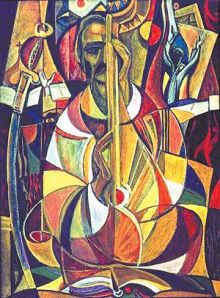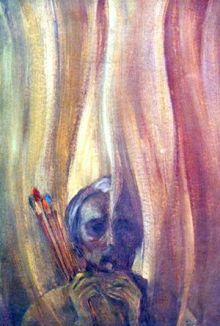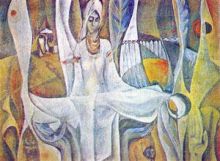Opanas Zalyvakha was born on November 26, 1925, in the village Husyntsi, Kharkiv region. He spent his childhood in the Far East, where he finished school. Then he entered Leningrad’s Repin State Museum of Painting. In 1957 the young artist went for an internship to the raion center Kosiv, Ivano-Frankivsk oblast. Four years later he settled in Ivano-Frankivsk region for good. In 1961, several days after a vernissage, Zalyvakha’s private exhibit was closed, following the order of the secretary of the oblast committee of the Communist Party. The reason given was the “decadent mood of the exhibit.”
Apparently, the “decadent mood of the exhibit” is a combination of modernist figurativeness and the traditions of folk art. These features are typical of the artist’s creative work, and appeared in the famous Shevchenko stained-glass window triptych, which has become an art symbol for the Sixtiers. In 1964, for Shevchenko’s anniversary, Zalyvakha together with Alla Horska, Liudmyla Semykina, Halyna Zubchenko and Halyna Sevruk created a stained-glass window for the then Kyiv-based Shevchenko State University. But, as is known, it was destroyed, following the order of the party leadership. This marked the beginning of a new wave of repressions against the Ukrainian intelligentsia. It was Zalyvakha’s magnum opus. After the window was destroyed, the artist was convicted of anti-Soviet nationalistic activity and sentenced to a five-year imprisonment in a Mordovian maximum security camp. There the artist worked as a loader, then as a stoker. He painted in his free time, but shortly after his paintings were seized.
In the last year of his life Zalyvakha did not sell his pictures, hoping that he would open a museum. In 1995 he won the Shevchenko Prize. The artist resided in Ivano-Frankivsk with his wife Daria, Stepan Bandera’s niece. He was greatly honored by Ukrainian artists, and many artists of the Transcarpathian capital call him their teacher. In particular, those include an artist from Ivano-Frankivsk Bohdan Brynsky:
“Opanas Zalyvakha is a phenomenal personality. He was born in eastern Ukraine, grew up in a different part of the world, in the Far East, mastered painting in Saint Petersburg, worked in Kyiv for a long time, and settled here, in Ivano-Frankivsk. I have said ‘he mastered,’ but this phrase is not appropriate here, because Zalyvakha was a natural, moreover he was our ‘national’ artist with a natural gift. For the national spirit dominated and was a priority at any stage of his life. There was nothing theatrical or for appearances sake about it, it was deep and conscious. When I asked him where he found the images for his works, he would reply that he saw them, that he did not invent anything, depicting only what his eyesight saw.”
Recently Zalyvakha’s forgotten masterpieces, which had been considered lost, have been found. Asked about them, Brynsky says:
“In December 2009, old friends and admirers of Zalyvakha’s creative work gathered in the art gallery Tsmok in Ivano-Frankivsk to honor his memory and draw attention of the public and cultural circles to the master’s personality. It was then that the ceramic works by Zalyvakha were shown — small sculptures from a decorative works series. They used to adorn the cafe Medivnia in Ivano-Frankivsk. For a long time this earthenware was lying covered with dust in the attic of the cafe, and the new owner kindly agreed to give these works to me. I have restored them, and they have been granted a new life. Unfortunately, Ukraine does not have a museum dedicated to Opanas Zalyvakha, where these truly fairytale-like sculptures could be included in a regular exposition. I think such a museum will be established in the future.”
The artist’s wife, Daria Zalyvakha, recalls, “Opanas was an absolute artist, but at the same time he was very tolerant, contrary to the popular opinion about bohemian artists. He was extremely humane and never blamed anyone for anything. Even those who sent him to jail. I have never heard him say anything bad about them. And there are many symbolical things among Panas’ works. I still find new elements in the pictures, which I have seen many times. Panas painted many images of the Madonna. He depicted Her as a Ukrainian woman. For example, the sketch for the well-known university stained-glass window. I think this image will never be outdated, it is eternal.”
Zalyvakha’s old-time acquaintance, currently a member of the Ivano-Frankivsk Oblast State Administration Zinovii Shkutiak recalls:
“You know, Opanas often repeated the phrase, ‘Live your life in such a way that you would never want to repeat it.’ In it I can see the whole essence of what Zalyvakha was like. One put effort into one’s life, so that people see that one lived it fully. The wonderful ceramic images created by Opanas in the style of Franko’s Zakhar Berkut will be a source of inspiration and a good example for future generations. Of course, Ivano-Frankivsk’s community would like to see these works in a proper condition in an appropriate place, i.e., an Opanas Zalyvakha Museum. And to establish it we need the good will of the artist’s family and cooperation between the public and the authorities.”
Over one year has passed since the presentation of Zayvakha’s sculptures. No museum has been established as yet. The artist’s wife says that this could be a house-museum; moreover, the house where Zalyvakha lived and worked could be used as museum’s premises. The artist’s works are still waiting for their moment.









